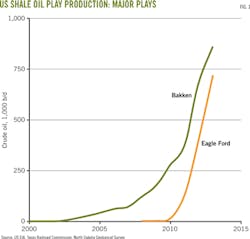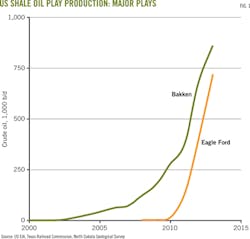Study finds simulation flaws in multiphase environment
Hamed Mansoori
Vahid Mobedifard
A. Mohammad Kouhpeyma
South Zagros Oil & Gas Production Co.
Shiraz, Iran
Olga software can be used to simulate multiphase pipeline flow at a wide range of rates without the need to match results to field data. Pipesim, however, does not reliably predict pressure drop at low natural gas flow rates and should be matched with field data to ensure accurate predictions.
Gas flow rate can affect liquid holdup and thus pressure-drop prediction. Pressure-drop predictions can vary greatly depending on the software used. In the movement of natural gas through pipes, the associated pressure and temperature of the fluid flow are subject to change throughout the pipe.1 Frictional loss, elevation change, Joule-Thomson effect, and heat exchange between the pipe and its surroundings lead to pressure and temperature changes. These changes make liquid and solid hydrate formation probable,2 in turn creating an unsteady pressure profile in the pipe.
Predicting the behavior of a multiphase system, even in steady state, is complex. An accurate simulation or prediction can help in the design of the pipe network and in selection of the proper solution to potential operating problems. Careless selection of existent correlations and equations, however, without attention to the nature of the issue, may lead to considerable errors in prediction results.3
Al Amal Petroleum Co. (Amapetco) in Egypt last year used Pipesim in an effort to optimize multiphase subsea flow and produce its reservoirs to full potential.4 The company also sought to overcome flow assurance problems brought about by hydrate formation and other issues. Simulation scenarios included gas only, oil only, and multiphase flow.
The history-matched model Amapetco built allowed it to increase network capacity and cut expenses. Users of both Pipesim and Olga, however, have noted differences in output even when using the same mass flow rates, gas-liquid compositions, and geometrical data.5
Olga is a dynamic simulator. Pipesim acts in steady state.6-7 To compare the two simulators, this article uses only Olga's steady-state function, applying both it and Pipesim to an actual multiphase wet gas transmission pipeline and comparing the results with those of field data for a range of gas flow rates.
Pipeline condition
The studied pipeline is in southern Iran, moving natural gas from a production field to a separation plant where gas, condensate, and water are separated without chemical treatment. The pipeline is 63 km long and buried at 1 m. Fig. 1 shows its elevation profile, while Tables 1 and 2 display fluid analysis and pipe condition, respectively.
The pipeline's first 22 km uses 24-in. OD pipe with the remaining 41 km using 26-in. OD. A maximum 18.7 million cu m/day (MMcmd) travels through the line, equivalent to the field's peak winter production. The field has 18 active wells producing at a condensate-gas ratio of 252 bbl/million cu m.
The elevation difference between the field and separation-nearly 1,000 m-allows easy multiphase shipment without slugging. After leaving the separation site, however, gas and condensate travel across a relatively flat landscape in separate 36-in. OD and 6-in. OD pipelines to a treatment plant.
Simulation
Performing computer simulation by Olga and Pipesim required dividing the line into 29 segments corresponding to the changes in elevation of the pipeline profile. The Peng-Robinson equation of state calculated thermodynamic properties for both simulators. The Beggs-Brill correlation predicted pressure drop in Pipesim, with total pressure drop (tp) equal to the summation of friction loss (f), elevation change (ele), and velocity change (acc) (Equation 1-2).3
Olga is a three-fluid model, applying separate continuity equations for the gas, oil (or condensate) or water liquid phases, and oil or water droplets. Numerical solutions for momentum, continuity, and energy equations for liquid, gas, and liquid droplet phases, took place simultaneously.5
Results
Fig. 2 shows Pipesim and Olga results for pressure drop at maximum capacity. The simulations displayed a similar overall pattern. The two, however, calculated liquid formation differently, leading to the displayed difference in predicted outlet pressure.
The pipeline operated at maximum rates for 1 year, except for when maintenance took place at the downstream processing plant when reductions occurred. Fig. 3 shows the two simulators' results for inlet pressure-drop prediction when the line is operating at 3 MMcmd, at which Pipesim and Olga have completely different results.
Olga still keeps a positive ΔP with higher pressure upstream than downstream, while Pipesim predicts lower upstream pressure than downstream. The studied pipeline transports in multiphase mode without large differences in the phase envelop drawn by the two software (Fig. 4), meaning the remarkable mismatch in calculated pressure profiles at low flow rates can be attributed to the liquid holdup prediction.
Reduction in gas velocity leads to formation and accumulation of liquid in the pipe. The more liquid in the pipe, the greater the pressure drop. Olga predicts this liquid formation well. Pipesim's depiction of liquid holdup remains almost unchanged as gas flow varies (Fig 5a), while Olga's liquid holdup prediction changes with gas flow (Fig. 5b).
Fig. 6 shows the pressure profile of the studied pipe at different gas rates, comparing simulation results with field data. For flow rates greater than 10 MMcmd, there is a good match between results by simulators and those of field data. For rates less than 10 MMcmd, however, a mismatch exists between field data and Pipesim's predictions, created by Pipesim's underestimation of liquid holdup at low flow rates. Olga's results generally match well with field data in all flow ranges.
Acknowledgement
The authors express their gratitude to South Zagros Oil & Gas Production Co. for its support on this study.
References
1. Brill, J.P., and Beggs, H.D., "Two Phase Flow In Pipes," 6th Ed., Tulsa: Tulsa University Press, 1991.
2. Mokhatab, S., Poe, W., and Speight, J., "Handbook of Natural Gas Transmission and Processing," Elsevier, 2006.
3. Moshfeghian, M., "Two Phase Gas-Liquid Pipeline Simulation," John M. Campbell Tip of the Month, June 2008.
4. "AMAPETCO Optimizes Subsea Flow Assurance with PIPESIM modeling," Schlumberger, 2013.
5. http://www.egpet.net/vb/threads/68832-Differences-PIPESIM-OLGA, Aug. 26, 2013.
6. PipeSim version 2008.1, Schlumberger.
7. OLGA version 6.0, SPT Group, Kjeller, Norway, 2008.
The authors
Hamed Mansoori ([email protected]) has 9 years' experience with South Zagros Oil & Gas Production Co. as process engineer. He holds a BS in chemical engineering from Islamic Azad University, Iran, and an MS in chemical process engineering from Shiraz University.
Vahid Mobedifard ([email protected]) is a senior process engineer with South Zagros Oil & Gas Production Co. with more than 8 years' experience. He holds a BS in chemical engineering from Persian Gulf University, Iran, and received his MS in chemical and gas engineering from Petroleum University of Technology, Iran.
A. Mohammad Kouhpeyma ([email protected]) is head of process engineering at South Zagros Oil & Gas Production Co. with more than 20 years' experience. He holds a BS in chemical engineering from Petroleum University of Technology, Iran, and received his MS in petroleum engineering from the University of Calgary, Canada.

